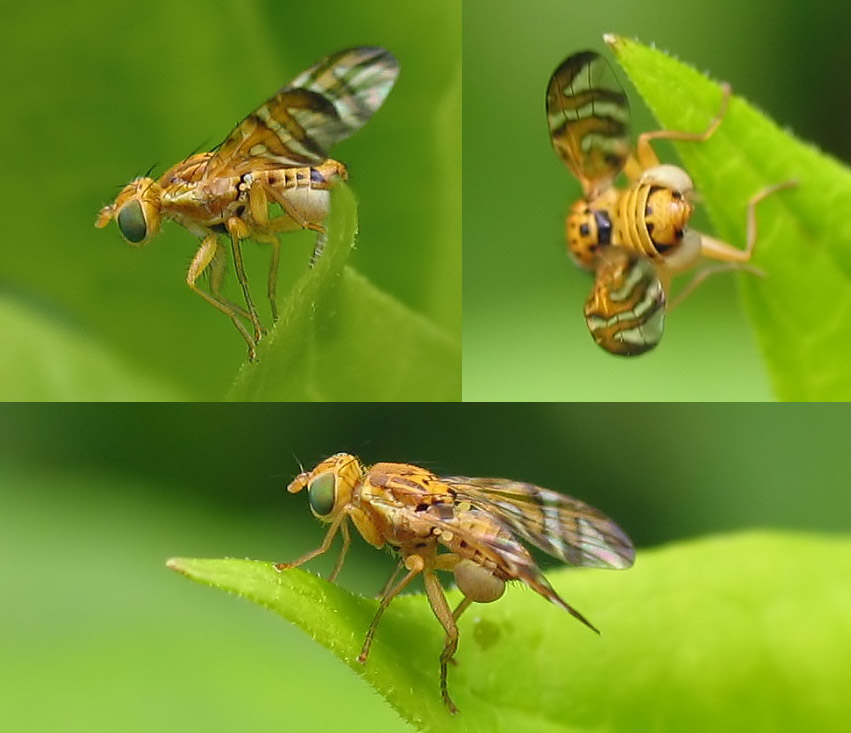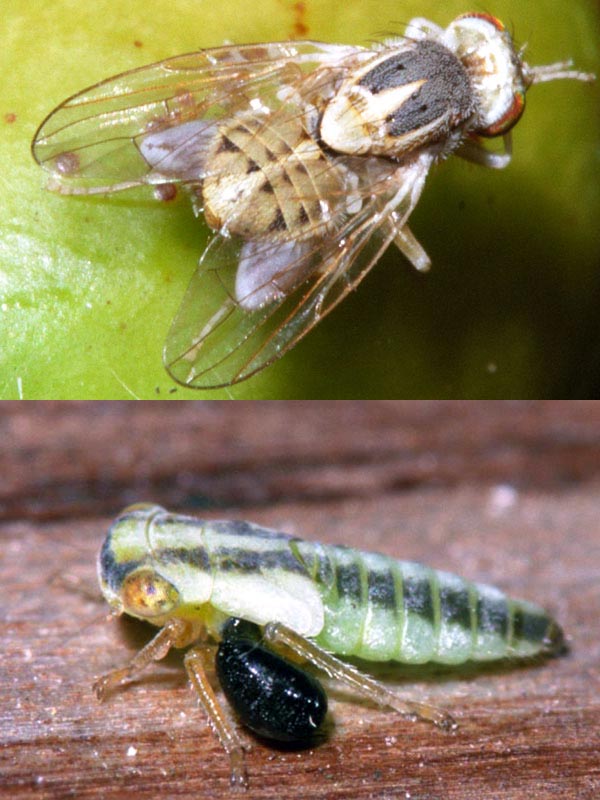Diptera.info :: Identification queries :: Diptera (adults)
Page 1 of 2: 12
|
|
Tephritid pheromones
|
|
| Ben Hamers |
Posted on 26-09-2007 19:57
|
|
Member Location: Heerlen ( Holland ) Posts: 739 Joined: 16.12.04 |
Good evening, Don't bother about the fly, it's a male Terellia serratulae, but please enlighten me about the two cocoons (?) it carries. Ben Ben Hamers attached the following image:  [62.64Kb] Edited by Ben Hamers on 21-05-2012 18:40 |
| jorgemotalmeida |
Posted on 26-09-2007 20:02
|
|
Member Location: Viseu - PORTUGAL Posts: 9296 Joined: 05.06.06 |
perhaps parasitised by any Braconidae wasp???  |
| cthirion |
Posted on 26-09-2007 21:20
|
|
Member Location: Awirs (Flémalle) Belgique Posts: 901 Joined: 13.08.04 |
To my knowledge, Braco and Ichneumonidae do not parasitize adult stage!
Edited by cthirion on 26-09-2007 21:23 cthirion |
| Tony Irwin |
Posted on 27-09-2007 00:00
|
|
Member Location: Norwich, England Posts: 7327 Joined: 19.11.04 |
This one is wierd! It reminds me a bit of Dryinidae parasites of homoptera - they produce a puparium that protrudes from between the abdominal segments of the host, but I've never heard of it happening in an adult tephritid. 
Tony ---------- Tony Irwin |
|
|
|
| Dima DD |
Posted on 27-09-2007 11:47
|
|
Member Location: St.Petersburg, Russia Posts: 75 Joined: 28.11.05 |
I also have old photos of another tephritid looking like a "bomber". I thought before that these symmetric "bombs" may be integral components of the fly!  But I'm not a specialist... But I'm not a specialist...Russia, near St-Petersburg (Toksovo), 30.07.2005 14:11 Dima DD attached the following image:  [99.06Kb] |
| jorgemotalmeida |
Posted on 27-09-2007 12:02
|
|
Member Location: Viseu - PORTUGAL Posts: 9296 Joined: 05.06.06 |
Maybe John Smit knows about this... |
| Ben Hamers |
Posted on 27-09-2007 17:29
|
|
Member Location: Heerlen ( Holland ) Posts: 739 Joined: 16.12.04 |
Very nice that Dima's fly is also a Tephritid, with the same symmetry of the cocoons. To compare, here is another picture of the T.serratulae and also a Dryinidae sp. parasiting an Idiocerus. Ben Hamers attached the following image:  [97.51Kb] Edited by Ben Hamers on 21-05-2012 18:44 |
| Tony Irwin |
Posted on 27-09-2007 18:41
|
|
Member Location: Norwich, England Posts: 7327 Joined: 19.11.04 |
I think I'll retract the Dryinidae suggestion - these swellings are too symetrical. I'd agree with Dima that these are part of the fly - tephritid males are known to use pheromones to attract females, and I suspect that these "balloons" are involved in that activity. There does not appear to be any easily accessed on-line information about this. The most promising Google suggestions all end up at one of those "Pay us some money and we'll let you read the article!" sites.  Great pictures from Dima and Ben, though! 
Tony ---------- Tony Irwin |
|
|
|
| jorgemotalmeida |
Posted on 27-09-2007 22:13
|
|
Member Location: Viseu - PORTUGAL Posts: 9296 Joined: 05.06.06 |
what a strange activity of pheromones producing such "balloons"  |
| pierred |
Posted on 28-09-2007 05:48
|
|
Member Location: Paris (France) Posts: 1484 Joined: 21.04.05 |
Hello, I would favour the idea of a parasit because it seems that the segments of the abdomen can't freely deploy, hindered by the balloons. This is noticeable on all Tephritids photos of the thread. Its looks like the stylopized hymenoptera, where the parasit is more deeply in the abdomen, with only a small protrusion of a part of the body toward outside. Pierre Duhem |
|
|
|
| Jan Willem |
Posted on 28-09-2007 07:59
|
|
Member Location: Waalwijk, The Netherlands Posts: 2161 Joined: 24.07.04 |
Insteresting! I've seen similar symetrical "balloons" in Empididae (I don't remember which genus or species) several years ago (unfortunately I have no photos of this phenomenon). Jan Willem Edited by Jan Willem on 28-09-2007 13:37 |
|
|
|
| Dima DD |
Posted on 28-09-2007 10:24
|
|
Member Location: St.Petersburg, Russia Posts: 75 Joined: 28.11.05 |
In spite of the fact that some flies really has interesting symmetric abdominal appendices (I observed Lauxaniidae?-Sapromyza? females exposing small "hornlets" right before/at mating, I think about those pheromones...) these "bombs" may be parasitic cocoons, of course. Their symmetry may reflect specific oviposition scenario: when parasite put only 2 eggs just in these special places of this small carrier, it increase probability of larvae survival. I noticed the fact that carrier is alive (and in good health?) when larvae already reached pupa stage... P.S. BTW I noticed also barely visible lines resembling notching on "bombs", on my first photo... And the hind view looks strange for me...Bean-shaped? 
Edited by Dima DD on 28-09-2007 10:41 |
| jorgemotalmeida |
Posted on 28-09-2007 10:53
|
|
Member Location: Viseu - PORTUGAL Posts: 9296 Joined: 05.06.06 |
maybe it serves to balance the flight of fly.  Imagine what would be the flight just with one balloon. Imagine what would be the flight just with one balloon.  If it is really a parasitoid, which would be the hypothesis? |
| John Smit |
Posted on 28-09-2007 11:43
|
|
Member Location: Utrecht Posts: 565 Joined: 05.10.04 |
Hi All, Ben sent me the photo's hoping to get an answer on the strange 'balloons'. As I had never seen this before, I didn't have an answer. At first I thought of a parasite as well, though the symetry is staggering!! I send these pictures to two other Tephritid specialist and one of them had the hypothosis(!) that it might be pheromon producing organs, which are inflated to spread them more easily. He had seen it several times within Tephritids, but also in Lauxanids! His argument for these swollen arguments are interesting, for as you can see the Terellia has no wingpatter, belonging to a terribly complex species-group, of which several species are known to occur sympartically on the same host!! In order to rule out the accident of trying to copulate with the wrong species, normally acounted for by the wingdisplay of Tephritids, the males produce these pheromones. Very interesting. Especially the photo's of Dima. For this species Goniglossum wiedemanni, does have a wingpattern and should not have to rely on the pheromones, but rather on the display of the wings, which I have seen them do in the field. Nevertheless also the species with wingpatterns do produce of course pheromones. In any case, it's neither a Dryinidae, as you can see from Ben's picture, which is always a really sack-like body, and as far as I know always black, besides the fact that they only attack Cicada's. Nor is it a Strepsipteron, the male puparia look different, darker in colour and with a clearly visible head-capsule, wtih structures like mandibles and eye-spots (which are light penetrant and which help the male emerge when the light is sufficient), furthermore the puparium of a Strepsipteron never protrudes as far as these balloons. Oh, and it's neither a female strepsipteron for the cephalothorax that protrudes only a little is much more flattened in all species I know of Strepsiptera. There is one species of Strepsiptera that attacks Tephritids: Dipterophagus dacini (or something similar), which attacks Dacus and Bacrtocera somewhere in Australia and / or Southeast Asia. John |
| Paul Beuk |
Posted on 28-09-2007 12:01
|
|
Super Administrator Location: Netherlands Posts: 19403 Joined: 11.05.04 |
Jan Willem wrote: These are 'extensible sacs' used for display in mating swarms.
Insteresting! I've seen similar symatrical "balloons" in Empididae (I don't remember which genus or species) several years ago (unfortunately I have no photos of this phenomenon). Paul - - - - Paul Beuk on https://diptera.info |
| Dima DD |
Posted on 28-09-2007 19:49
|
|
Member Location: St.Petersburg, Russia Posts: 75 Joined: 28.11.05 |
John, thank you for very interesting information! It's also interesting that (as I understood), these specii normally manage without balloons (especially patterned ones) and only rare individuals carry this extra load. So, another hypothesis: it may be some kind of illness pathology, too (e.g. caused by viruses...). BTW, disease may affect pheromone-producing organs as well... This explanation fits all facts that I know at this moment... John Smit wrote: ...He had seen it several times within Tephritids, but also in Lauxanids! I'm planning to prepare and post several photos of mating Lauxanids on which exposing of "abdominal hornlets" by females(! - if I'm not mistaken...) is clearly visible!  But not right now, sorry... But not right now, sorry...  John Smit wrote: ...For this species Goniglossum wiedemanni... Thank you once more!  Dima. |
| John Smit |
Posted on 28-09-2007 21:25
|
|
Member Location: Utrecht Posts: 565 Joined: 05.10.04 |
Hi Dima, I still think it has nothing to do with deseases or anything. And sorry I made a mistake, four species is a Chaetorellia or Chaetostomella, therefore the same accounts for your species as for the Terellia, numerous sibling species... sorry! I'll get back to the identification of your species. Anxious to see your post on Lauxanids John |
| Dima DD |
Posted on 28-09-2007 23:06
|
|
Member Location: St.Petersburg, Russia Posts: 75 Joined: 28.11.05 |
John Smit wrote: Hi Dima, I still think it has nothing to do with deseases or anything. And sorry I made a mistake, four species is a Chaetorellia or Chaetostomella, therefore the same accounts for your species as for the Terellia, numerous sibling species... sorry! I'll get back to the identification of your species. Anxious to see your post on Lauxanids John Oops! - it's my fault at first...  I found Chaetostomella cylindrica (Loew, 1846) in our Gallery, compared with my fly - and didn't find any differences: I found Chaetostomella cylindrica (Loew, 1846) in our Gallery, compared with my fly - and didn't find any differences:http://www.dipter...to_id=1579 |
| John Smit |
Posted on 29-09-2007 10:36
|
|
Member Location: Utrecht Posts: 565 Joined: 05.10.04 |
Hi Dima, No, you're probably right, it's probably C. cylindrica! But I'ld like to push it trough a key nevertheless, just to be sure.. John |
| Kahis |
Posted on 29-09-2007 11:36
|
|
Member Location: Helsinki, Finland Posts: 1999 Joined: 02.09.04 |
I think they are inflatable sections of the pleural membrane. They can be found in several families, - but usually on females. At least in Lauxanidae, the surface of the sacks have very dense, specialised microsetae. When a fly is dehydrated in acetone, these structures are often inflated and they stay visible on dired specimens. Kahis |
Page 1 of 2: 12
| Jump to Forum: |













